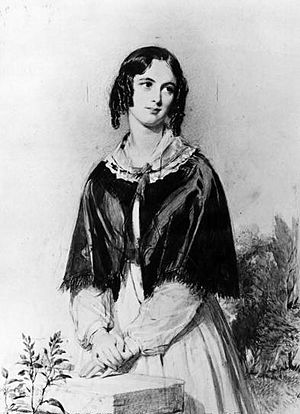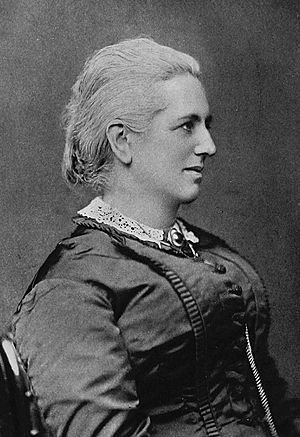Charlotte Mary Yonge facts for kids
Quick facts for kids
Charlotte Mary Yonge
|
|
|---|---|

Yonge, aged 35
|
|
| Born | 11 August 1823 Otterbourne, Hampshire, England |
| Died | 24 May 1901 (aged 77) Otterbourne, Hampshire, England |
| Occupation | Novelist |
| Nationality | English |
| Period | 19th century |
| Genre | Children's literature |
Charlotte Mary Yonge (1823–1901) was an English writer. She wrote many novels that were popular in her time. Her books often supported the ideas of the Oxford Movement, a religious group. She also wrote about important topics like public health. Many of her books are not printed anymore.
Contents
Life of Charlotte Mary Yonge
Charlotte Mary Yonge was born in Otterbourne, England. Her birthday was August 11, 1823. Her parents were William and Fanny Yonge.
Early Education and Family
Charlotte was taught at home by her father. She learned subjects like Latin, Greek, French, and math. Her father was a strict teacher. She once said that his approval made her very happy. She also said his anger made her sad. She loved working with him. Their lessons continued until she was over twenty years old.
Charlotte deeply respected her father. Their relationship was very important to her. She stayed in Otterbourne her whole life.
Religious Beliefs and Community Work
Charlotte grew up in a religious family. She was a strong follower of the High Church. She was greatly influenced by John Keble. He was a vicar (a type of priest) nearby. He was also a leader of the Oxford Movement. This movement aimed to bring back older Christian traditions.
Charlotte is sometimes called "the novelist of the Oxford Movement." Her novels often showed the values of this group. For 71 years, she taught at the village Sunday school. She lived in a house called Elderfield.
Naming a New Parish
In 1868, a new church area was created. It was south of Charlotte's home village. This new area included the villages of Eastley and Barton. Charlotte gave £500 to help build the parish church. She was asked to choose the name for the new area. She picked Eastley. But she decided it should be spelled Eastleigh. She thought this spelling looked more modern.
Her Final Years
Charlotte Yonge passed away in Otterbourne on May 24, 1901. The Times newspaper wrote about her death. They said her friends knew her strong and kind character. They also said she was a very inventive writer. She wrote mostly for young people, especially girls. Her books showed her strong religious beliefs.
Charlotte Yonge's Writing Career
Charlotte Yonge started writing in 1848. During her long life, she published about 160 books. Most of these were novels.
First Success and Charity
Her first big success was The Heir of Redclyffe (1853). The money from this book helped buy a ship. This ship, called Southern Cross, was used for missionary work. She used the money from other novels for charity too.
Editing a Magazine
Charlotte also started and edited a magazine. It was called The Monthly Packet. She edited it for forty years, starting in 1851. This magazine was for British Anglican girls. Later, it reached a wider group of readers.
Famous Works and Other Writings
Some of her most famous books include The Heir of Redclyffe, Heartsease, and The Daisy Chain. A Book of Golden Deeds is a collection of true stories. These stories are about brave acts and self-sacrifice.
She also wrote Cameos from English History. Another book was Life of John Coleridge Patteson: Missionary Bishop of the Melanesian Islands. Her book History of Christian Names was very important. It was the first serious study of names.
Supporting Young Writers
Around 1859, Charlotte started a writing group. It was for her younger girl cousins. They wrote essays and got advice from Charlotte. They even made their own private magazine called "The Barnacle." This group continued until about 1871. This was important because many girls at that time were still educated at home.
Charlotte also had a big influence on her god-daughter, Alice Mary Coleridge. This influence helped lead to the founding of Abbots Bromley School for Girls. After Charlotte died, her friend Christabel Coleridge wrote a book about her life. It was called Charlotte Mary Yonge: her Life and Letters (1903).
Charlotte Yonge's Reputation
Charlotte Yonge's books were very popular in the 1800s. Many famous people admired her work.
Admirers and Influence
Some of her fans included Lewis Carroll, George Eliot, and Anthony Trollope. William Morris and Edward Burne-Jones were students at Oxford University. They read The Heir of Redclyffe aloud to each other. They were inspired by the hero, Guy Morville. His medieval tastes helped form the Pre-Raphaelite Brotherhood. This was a group of English artists.
Charlotte Yonge's work was often compared to other great writers. These included Jane Austen and Honoré de Balzac.
Sir John Arthur Ransome Marriott was a British politician. He said Charlotte Yonge was a serious history student. He praised her historical novels. He hoped her stories would encourage young readers to explore history themselves.
Impact on Readers
Her books were so popular that a sailor could remember a missing page from The Daisy Chain. An army officer said his main goal in life was to be like Guy Morville. Guy was the hero of The Heir of Redclyffe.
C. S. Lewis, a famous writer, thought highly of Yonge. He said her descriptions of home life were as good as those by Homer and Leo Tolstoy.
Abraham Kuyper, a Dutch politician, read The Heir of Redclyffe. He found it very moving. He said it was "next to the Bible in its meaning for my life."
Social Themes in Her Novels
Charlotte Yonge's novels often discussed problems of her time. These included city pollution and public health. She wrote about epidemics like cholera and typhoid. She cared deeply about improving Victorian cities. Her stories showed the good and bad sides of trying to make changes. They also showed the difference between selfish people and brave, kind people.
Today, Charlotte Yonge's work is not studied as much. The Heir of Redclyffe is one of her most well-known books that is still looked at.
Works by Charlotte Mary Yonge
- Abbeychurch; or, Self Control and Self Conceit (1844)
- The Heir of Redclyffe (1853)
- Scenes and Characters; or, Eighteen Months at Beechcroft (1853?)
- Heartsease; or, The Brother's Wife (1854)
- The Little Duke: Richard the Fearless (1854)
- The Lances of Lynwood (1855)
- The Daisy Chain, or Aspirations (1856)
- Marie Thérèse de Lamourous: Foundress of the House of la Misércorde, at Bourdeaux (1858)
- Countess Kate (1860)
- Friarswood Post-Office (1860)
- The Young Step-Mother; or a Chronicle of Mistakes (1861)
- A Book of Golden Deeds of All Times and All Lands (1864)
- The Trial; or, More Links of the Daisy Chain (1864)
- The Clever Woman of the Family (1865)
- The Prince and the Page: A Story of the Last Crusade (1866)
- The Dove in the Eagle's Nest (1866)
- The Chaplet of Pearls; or, The White and Black Ribaumont (1868)
- Cameos from English History, from Rollo to Edward II (1868)
- Little Lucy's Wonderful Globe and Other Stories (1871)
- Aunt Charlotte's Stories of Greek History (1873)
- Life of John Coleridge Patteson: Missionary Bishop of the Melanesian Islands (1874)
- Young Folks' History of Rome (1878)
- Young Folks' History of England (1879)
- Magnum Bonum; or, Mother Carey's Brood (1879)
- Unknown to History: A Story of the Captivity of Mary of Scotland (1881)
- History of France (1882)
- The Armourer's Prentices (1884)
- History of Christian Names (1884)
- The Two Sides of the Shield (1885) – sequel to Scenes and Characters,
- Hannah More (1888)
- A Reputed Changeling (1889)
- Two Penniless Princesses (1891)
See also
 In Spanish: Charlotte Yonge para niños
In Spanish: Charlotte Yonge para niños



